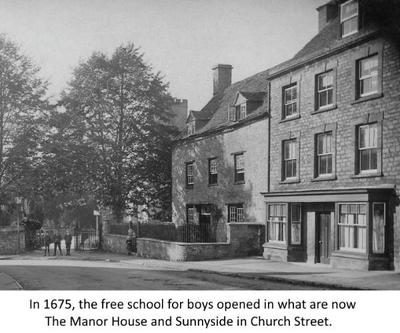
The History of Charlbury through .... the gift of a 17th century lady
Ann Lovett for Charlbury Museum
On 7th January 1631 James Walker, yeoman, of Charlbury wrote his will. It was much concerned with his wife, Anne, and their as yet unborn first child, and how they would be provided for. He and Anne Eyans had married in 1629. Sadly James died shortly after he made the will - Charlbury Parish Records (CPR) record his burial on the 18th February 1631. Two months later there is another entry recording the baptism of his daughter Anne on 17th April.
Very little is known about their daughter Anne after her baptism. Her mother married William Pitchford, a London haberdasher, in 1640. Pitchford is thought to have been Master of the Guild of Haberdashers at some stage. He had premises in Cheapside, and later lived in Hampstead. It would be a natural assumption that 9 year old Anne moved to London with her mother.
Her grandfathers, Edward Walker of Ratley, Warwickshire and Richard Eyans of Charlbury, both left her £5 in their wills of 1640 and 1653. Also, in the will of her stepfather William Pitchford in 1659……. I give my wife’s daughter Anne Walker 20 nobles* for mourning and £10…
On 20th March 1660 Anne wrote her will. There is no record of her death but probate was granted in 1667 for Anne Walker spinster of London.
She says “ Charlbury is Greate and full of poore Inhabitants who by reason of their greate poverty are not able to maintaine and educate their Children at school ”. So she settled her lands at Shotteswell, Warwickshire and Cropredy, Oxfordshire, left her by her father, on Brasenose College Oxford, to oversee a school in Charlbury and appoint a schoolmaster, to be paid £40 a year. Brasenose were also to provide a grant of £5 a year to 2 students, preferably from Charlbury, whilst at Brasenose. She wished her mother and uncle, another Richard Eyans, to ensure the renovation of the school. In 1675 the free school for boys, with accommodation for the schoolmaster, opened in what is now the Manor House and Sunnyside in Church Street.
In later years with the building dilapidated, Brasenose built new schoolrooms at what became Grammar School Hill. The Grammar School was open by 1837. It eventually closed in 1902 and by 1911 Charlbury Exhibition Foundation was formed. A legacy from (uncle) Richard Eyans , a piece of land in Charlbury known as Poor Boys Close, was included in the Foundation which still awards grants to Charlbury’s young people in apprenticeship schemes and in tertiary education.
So the legacy of a lady, born in Charlbury in 1631, who lived through the English Civil War, the Commonwealth, Restoration of Charles the second, the Great Plague and possibly the Great Fire of London continues to provide some educational needs today.
* A coin introduced under Edward III, originally worth 6s 8d. Mentioned in Shakespeare’s plays, they had gone out of use long before 1659.



